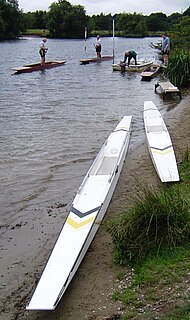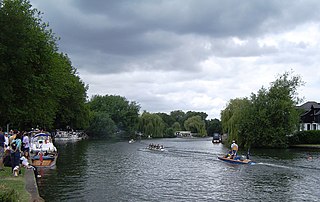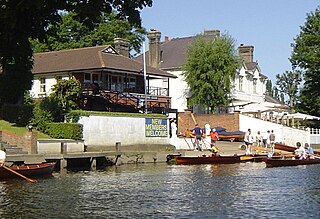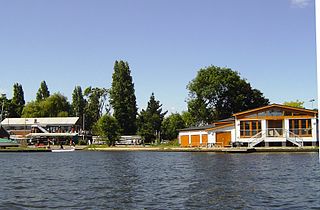
Rowing, sometimes called crew in the United States, is the sport of racing boats using oars. It differs from paddling sports in that rowing oars are attached to the boat using oarlocks, while paddles are not connected to the boat. Rowing is divided into two disciplines: sculling and sweep rowing. In sculling, each rower holds two oars—one in each hand, while in sweep rowing each rower holds one oar with both hands. There are several boat classes in which athletes may compete, ranging from single sculls, occupied by one person, to shells with eight rowers and a coxswain, called eights. There are a wide variety of course types and formats of racing, but most elite and championship level racing is conducted on calm water courses 2 kilometres (1.2 mi) long with several lanes marked using buoys.

Dinghy racing is a competitive sport using dinghies, which are small boats which may be rowboats, have an outboard motor, or be sailing dinghies. Dinghy racing has affected aspects of the modern sailing dinghy, including hull design, sail materials and sailplan, and techniques such as planing and trapezing.

Teddington Lock is a complex of three locks and a weir on the River Thames between Ham and Teddington in the London Borough of Richmond upon Thames, England. It was first built in 1810.

A punt is a flat-bottomed boat with a square-cut bow, designed for use in small rivers or other shallow water. Punting is boating in a punt. The punter generally propels the punt by pushing against the river bed with a pole. A punt should not be confused with a gondola, a shallow draft vessel that is structurally different, and which is propelled by an oar rather than a pole.

Kingston Rowing Club (KRC) is a rowing club in England founded in 1858 and a member club of British Rowing.

The Sunbury Amateur Regatta is a regatta on the River Thames at Sunbury-on-Thames, Surrey, England with a rare visitors' boats lights display and fireworks event. It is for mainly traditional wooden types of boats with a few events for small sculling boats since its instigation in 1877 taking place by convention on a Saturday in early to mid August. The following day hosts the Edith Topsfield Junior Regatta.

Dongola racing is a popular event in traditional local regattas, especially on the River Thames in southern England and was first competed at Maidenhead in 1886. Competitors use wide punts and a team of people with single-bladed paddles, facing forwards and kneeling, normally with one leg up and one leg down. The person at the rear is responsible for the steering with their paddle.
A Thames skiff is a traditional River Thames wooden rowing boat used for the activity of skiffing. These boats evolved from Thames wherries in the Victorian era to meet a passion for river exploration and leisure outings on the water.

Skiffing refers to the sporting and leisure activity of rowing a Thames skiff. The skiff is a traditional hand built clinker-built wooden craft of a design which has been seen on the River Thames and other waterways in England and other countries since the 19th century. Sculling is the act of propelling the boat with a pair of oars, as opposed to rowing which requires both hands on a single oar.

The River Thames is one of the main rowing areas in England, with activity taking place on the Tideway and on the 45 separate lock reaches on the non-tidal section. The river hosts two major rowing events, The Boat Race and Henley Royal Regatta, and many other regattas and long distance events take place on the river. Dorney Lake in Buckinghamshire was opened specifically as a rowing lake besides the Thames, and has become the venue for a few events that formerly took place on the river. Other lakes adjacent to the Thames are the Redgrave Pinsent Rowing Lake and Royal Albert Dock. Rowing, or sculling, includes skiffing, dinghy racing and cutter racing in which the boats are also propelled by blades.
The Skiff Club is the oldest skiff and punting club in existence, having been founded in 1895. It is based on the River Thames in London, on the Middlesex bank between Teddington Lock and Kingston upon Thames.

Thames Valley Skiff Club is an English skiff and punting club, which was founded in 1923. It is based on the River Thames in England, on the Surrey bank between Sunbury Lock and Walton on Thames.

Egham Regatta is a rowing regatta on the River Thames in England which takes place at the end of June on the reach above Bell Weir Lock near Egham, Surrey. The regatta is run from Wraysbury Skiff and Punting Club and the Runnymede Pleasure Grounds on the outskirts of Egham.
The Skiff Racing Association (SRA) is the governing body in the United Kingdom for the sport of skiff racing. The SRA is affiliated to British Rowing. The objectives of the SRA are

Wraysbury Skiff and Punting Club (WSPC) is an English skiff and punting club founded in 1931 based on the River Thames at the start of the Surrey section of the right bank – between the rest of Runnymede and Bell Weir Lock.

The Skiff Championships Regatta is the premier skiff racing regatta on the River Thames in England. It is held annually at Henley on the Sunday of August Bank Holiday weekend.

Dittons Skiff and Punting Club (DSPC or Dittons) is an English skiff and punting club, which was founded in 1923. It is based on the River Thames with a club and boat house at Thames Ditton on the reach above Teddington Lock. As well as taking part in regular skiff and punt racing competitions, crews from the club have established several rowing world records.

Hampton Court and Dittons Regatta is a regatta on the River Thames in England which takes place at Thames Ditton, Surrey beside Hampton Court Palace.
Thames Ditton Regatta is a rowing regatta, on the River Thames in England which takes place at Thames Ditton, Surrey opposite Hampton Court Palace.

Walbrook Rowing Club, colloquially sometimes named Teddington Rowing Club, is a rowing club, on the River Thames in England on the Middlesex bank just above Teddington Lock at Trowlock Island, Teddington and downstream of Molesey Lock. It is the first non-tidal club on the weir-controlled Thames and is the organising club for Teddington Head of the River Race held in November for all classes of racing shells.


















